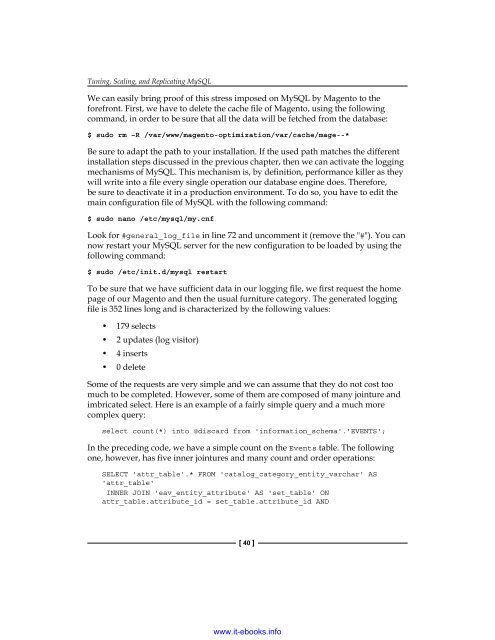Magento Site Performance Optimization
Create successful ePaper yourself
Turn your PDF publications into a flip-book with our unique Google optimized e-Paper software.
Tuning, Scaling, and Replicating MySQL<br />
We can easily bring proof of this stress imposed on MySQL by <strong>Magento</strong> to the<br />
forefront. First, we have to delete the cache file of <strong>Magento</strong>, using the following<br />
command, in order to be sure that all the data will be fetched from the database:<br />
$ sudo rm –R /var/www/magento-optimization/var/cache/mage--*<br />
Be sure to adapt the path to your installation. If the used path matches the different<br />
installation steps discussed in the previous chapter, then we can activate the logging<br />
mechanisms of MySQL. This mechanism is, by definition, performance killer as they<br />
will write into a file every single operation our database engine does. Therefore,<br />
be sure to deactivate it in a production environment. To do so, you have to edit the<br />
main configuration file of MySQL with the following command:<br />
$ sudo nano /etc/mysql/my.cnf<br />
Look for #general_log_file in line 72 and uncomment it (remove the "#"). You can<br />
now restart your MySQL server for the new configuration to be loaded by using the<br />
following command:<br />
$ sudo /etc/init.d/mysql restart<br />
To be sure that we have sufficient data in our logging file, we first request the home<br />
page of our <strong>Magento</strong> and then the usual furniture category. The generated logging<br />
file is 352 lines long and is characterized by the following values:<br />
• 179 selects<br />
• 2 updates (log visitor)<br />
• 4 inserts<br />
• 0 delete<br />
Some of the requests are very simple and we can assume that they do not cost too<br />
much to be completed. However, some of them are composed of many jointure and<br />
imbricated select. Here is an example of a fairly simple query and a much more<br />
complex query:<br />
select count(*) into @discard from 'information_schema'.'EVENTS';<br />
In the preceding code, we have a simple count on the Events table. The following<br />
one, however, has five inner jointures and many count and order operations:<br />
SELECT 'attr_table'.* FROM 'catalog_category_entity_varchar' AS<br />
'attr_table'<br />
INNER JOIN 'eav_entity_attribute' AS 'set_table' ON<br />
attr_table.attribute_id = set_table.attribute_id AND<br />
[ 40 ]<br />
www.it-ebooks.info


